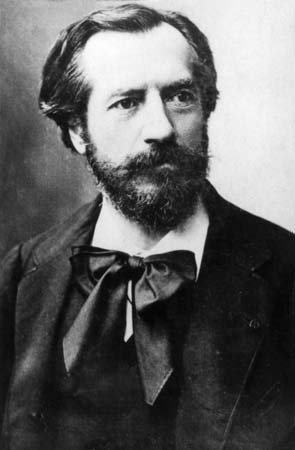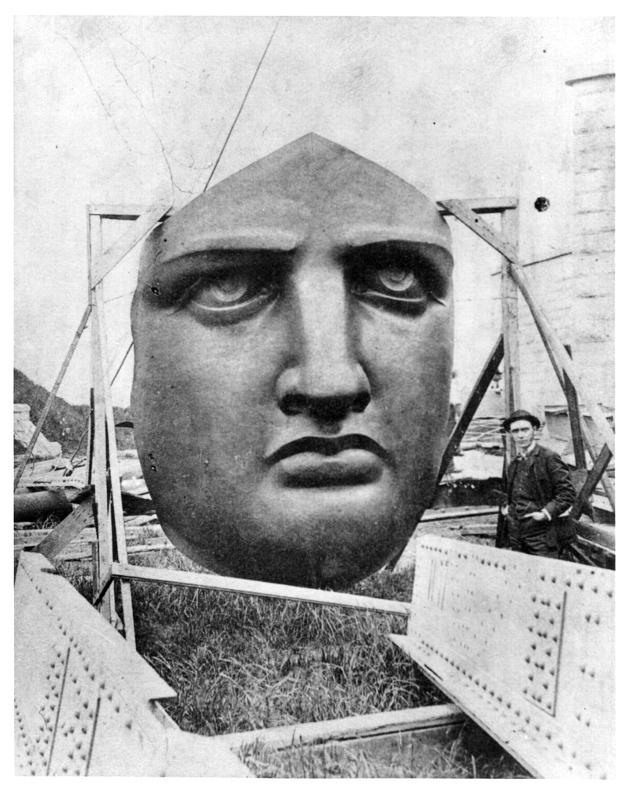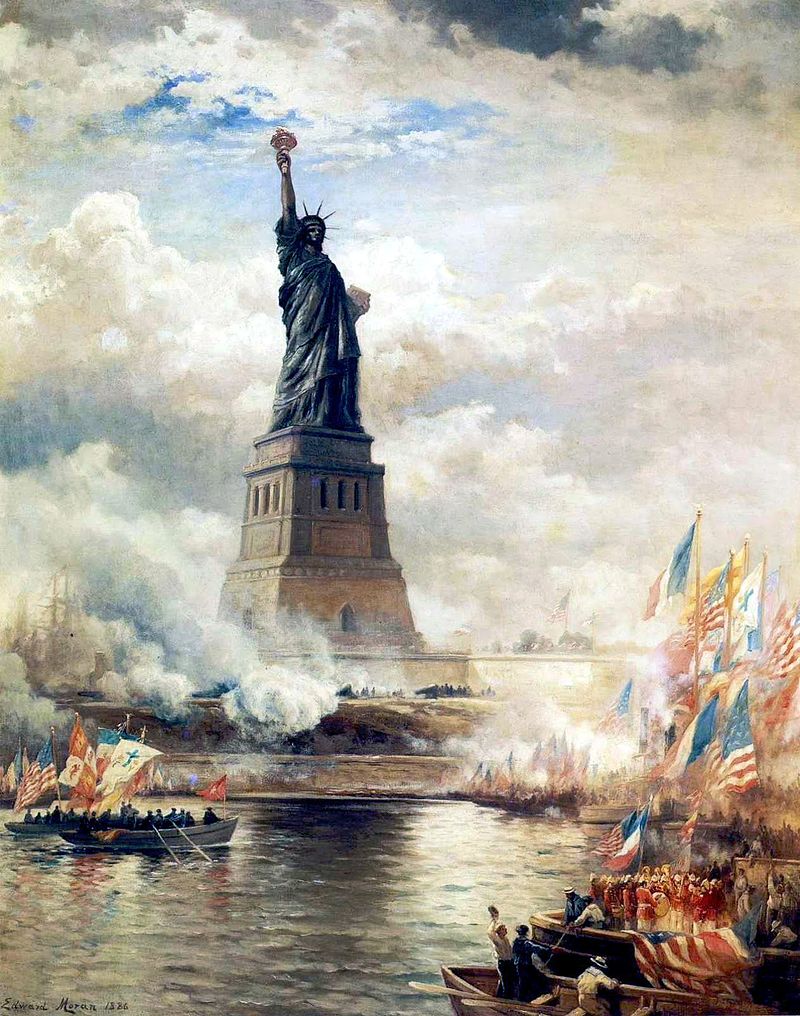The Statue of Liberty today is one of America’s most iconic landmarks. Opened to the public in late 1886, it is still standing and popular today. She was made of copper, though over time her skin has turned green. What was once called Bedloe’s Island was later named for the statue. It is now called Liberty Island, and is located in New York.
It is thought that the idea for the Statue of Liberty was first introduced to Edouard de Laboulaye, the president of the French Anti-Slavery Committee. A conversation was traced back to 1865 between Laboulaye and Frédéric Bartholdi, a sculptor. Laboulaye was thought to say, “If a monument should rise in the United States, as a memorial to their independence, I should think it only natural if it were built by united effort—a common work of both our nations.” A report in 2000 by the National Park Service, however, dated this to a pamphlet in 1885 and that the idea of the statue had 15 years earlier. Yet another essay stated that perhaps Laboulaye came up with the idea on congratulating America for having a democracy, not a monarchy, and abolishing slavery.
Bartholdi, when later telling the story, said that Laboulaye had inspired him, not given him a proposal. They could not really go anywhere with the plan though because of Napoleon’s rule over the country. After the Franco-Prussian war, Bartholdi planned a trip to America. He and Laboulaye discussed introducing their idea to influential Americans.
When Bartholdi sailed into New York Harbor, he saw Bedloe’s island. Bartholdi thought this a great place for the statue to go because all ships heading into New York would have to pass it. So, Bartholdi went to speak with President Ulysses S. Grant. He told Bartholdi that it would not be hard to put the statue on the island. From there, Bartholdi made two trips across America, speaking to anyone he though would support his idea.
In 1870, Bartholdi designed the first model of the statue. John La Farge, American artist and son to a friend of Bartholdi, later recounted that Bartholdi began his sketches while in America.
Laboulaye and Bartholdi began to work on finding the best way to depict and show American freedom. Two female figures were often used as symbols for America in early U.S. history. Columbia, one of the symbols, for the U.S. was as Brittania is for the United Kingdom. The second figure was Liberty. She had been derived from the goddess Libertas of freedom from Roman mythology. Coins were even decorated with the symbol of Liberty.
The pair had decided to stray from depicting Liberty like Eugène Delacroix in his painting Liberty Leading the People. While Liberty was shown only half-clothed leading men into battle, Bartholdi and Laboulaye decided that their depiction of Liberty would be fully clothed in flowing robes. They wished to give their statue a more peaceful look. Laboulaye and Bartholdi also decided on giving the statue a torch to represent progress.
Bartholdi’s early models of the statue were notably similar to the Statue of Freedom done by Thomas Crawford in the 1850s. Some even said that Bartholdi modeled the statue to look like his mother, but their is no real proof for that. Bartholdi designed the statue so that ships entering New York would have a different perspective on America and the statue. He even toyed with the idea of having the statue hold a broken chain.
Eugène Viollet-le-Duc was invited by Bartholdi to help contribute to the statue. He designed a pier made of bricks for the statue to stand on. Viollet-le-Duc also chose to use sheets of copper for the statue. Bartholdi had also just decided that he wanted his statue to be 151 feet tall.
In 1875, Laboulaye finally decided to reveal the idea to the public and gain more support. He also announced that it would be named Liberty Enlightening the World. Many were excited and supportive of the statue. However, some were against it because they were angry the U.S. did not help them during the Franco-Prussian war. Monarchists were all against it as well because of Laboulaye recently being elected senator for life. Laboulaye’s support only grew as he did all he could to make the statue known throughout France.
Laboulaye was also successful in raising funds for the statue across the country. Many even funded the project in hopes for the Americans to support France’s attempt to build the Panama Canal. Copper was also purchased and donated for the statue.
In May of 1876, Bartholdi went to the U.S. once again for the Centennial Exhibition. There he had arranged for a large painting of the statue to be on display in New York. Bartholdi had recently finished the torch-wielding arm and had it sent to Philadelphia. It arrived in late August and remained on display. Eventually it was set up in New York, then went back to France to join the rest of the statue. Bartholdi also addressed numerous large groups on his plans for the statue. President Grant signed an agreement stating that the U.S.A. would accept the statute and that a spot would be chosen for it. The next day, President Rutherford B. Hayes went into office and chose for the statue to go onto Bedloe’s island, as Bartholdi had originally proposed.
Upon arriving home in France, Bartholdi began to work on and finished the head for the statue. It was on display the following year, 1878, at the Paris World Fair. The money received by fundraising and donations only grew. France even held a lottery with prizes consisting of a silver plate and terracotta model of the statue.
Viollet-le-Duc died while helping Bartholdi construct the arm. He left no plans on how he was going to build the pier on which the statute would stand. So, Bartholdi hired Gustave Eiffel. Eiffel and his structural engineer, Maurice Koechlin, chose to build an iron truss tower rather than a pier. The iron truss tower Eiffel constructed for the statute made it one of the first example of a style of architecture called curtain wall bearing. Eiffel even added two spiral staircases into the interior to make it easier for visitors to go up the tower.
Originally Bartholdi was going to attach the copper skin onto the statue while in New York. Instead he decided to build the statue in France, then have it disassembled and sent to America. From there it would be assembled once more and on display for the people. Laboulaye soon died in 1883 though after contributing wonderfully to the project.
In Paris on July 4, 1884, the statue was finished and president to United States Ambassador to France Levi P. Morton. In January the next year, the statue was disassembled and sent to Bedloe’s island.
Unlike in France where they were able to easily gain funds, in New York they were having trouble raising funds for construction. Because of the Panic of 1873, the economy was struggling in the U.S. Americans and New Yorkers also believed that people born outside their borders should not be designing art in their country. Many also preferred more realistic artwork after the Civil War. Because of this, no progress was made on the statue for a few years to come.
The statue was designed and placed so it would face oncoming ships in New York. The New York committee had chosen Richard Morris Hunt to be the one to design the pedestal for the statue. Originally, he planned the pedestal to be 114 feet. Because they could not afford to construct one so large, they built an 89 foot pedestal instead. Hunt also wanted it to be built of granite, but was unable to once again because of money. Former army General Charles Pomeroy Stone was hired to be the one to oversee construction. In 1883, construction began on the foundation for the statue. Civil War engineer and immigrant from Norway Joachim Goschen Giæver designed the statue’s framework.
Poet Emma Lazarus was asked to write a poem for an auction about the statue after funding continued to fail. Originally she declined, but eventually agreed. In her poem she used the words “Statue of Liberty” when that had not been the original name of the statue.
The statue arrived from France on June 17, 1885. With the arrival of the statue, New Yorker grew more and more curious and excited about the project. Over 200,000 citizens stood on the docks to welcome the Isère, the ship carrying the statue. And finally, by August 11 enough money had been raised to fund the statue.
The pedestal was completed in April 1886. From there, construction on the statue began.
On October 28, 1886, a ceremony was held to dedicate the statue. A parade had been held earlier that day in New York. It is estimated that hundred of thousands of people, possibly even a million, watched the parade. Afterwards, people began occupying boats to sail to the statue. Bartholdi even accidentally let the flag fall before he was supposed to during a speech. The crowd had erupted into cheers. Only officials and dignitaries were allowed on the actually island. No women were allowed either with the exception of Bartholdi’s wife and the granddaughter of Ferdinand de Lesseps. It was stated that people feared women may be crushed by the crowds.





